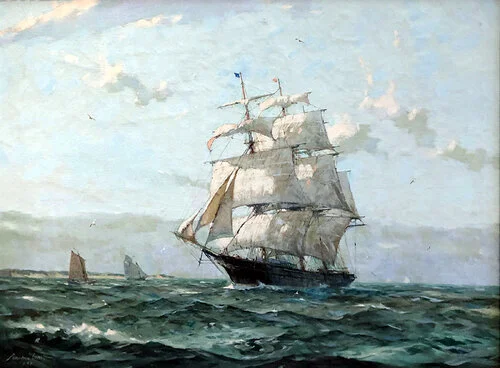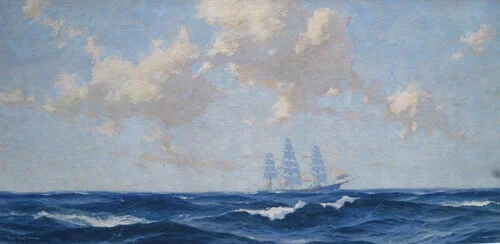Gordon Grant
(1875 - 1962)
Click on any of the images for painting dimensions and pricing
The late 19th and Early 20th century produced some of the greatest artists/illustrators America has ever known. Before widespread use of photography, they captured all aspects of American life with a realism that still resonates today. From Winslow Homer (1836-1910), and N. C. Wyeth (1882-1945), to Howard Pyle (1853-1911) and Norman Rockwell (1894-1978) – their work was seen by millions in newspapers, books, and art exhibitions. Gordon Grant was among this group, and like Winslow Homer, spent much of his career concentrating on maritime and coastal subjects.
Today his work is found in the Collections of the Metropolitan Museum of Art, NY, NY; the Smithsonian American Art Museum, Washington, DC; The U.S.S. CONSTITUTION Museum, Boston, MA; The White House Historical Association, Washington, DC; The Art Institute of Chicago; The Pennsylvania Academy; The Salmagundi Club, NY, NY; The National Gallery, Washington, DC; Corcoran Gallery of Art, Washington, DC; the DeYoung Fine Art Museum, San Francisco, CA; the U.S. Naval Academy, Annapolis, MD; and the Clark Art Institute, Williamstown, PA.
Gordon Grant was born in 1875 in San Francisco, California and was sent to school in Scotland as a youth. The four-month voyage by sailing vessel around the southern tip of South America and then across the Atlantic, made a tremendous impression on the young Grant and started a lasting fascination with the sea and sailing ships. He studied art at the Heatherly and Lambeth Art Schools in London and returned to San Francisco to work as a staff artist on both the San Francisco Chronicle and the Examiner newspapers. This was the period of the artist/reporter with on-the-spot drawings being made on battlefields and warfronts. Grant worked as a combat artist for Harper’s Weekly in the Boer War and the Mexican Revolution. In 1896, he joined the New York World magazine, and later was on the staff of Puck magazine for eight years. He joined the National Guard in 1907, and during World War I, when a bad foot prevented him from serving abroad. While in Washington, DC, Grant attained the rank of Captain and produced posters for the government and the American Red Cross to support the war effort. He was also the cover designer for the first edition of the Boy Scout Handbook in 1911
His fame as a painter of ships was greatly enhanced in 1926 when prints of his painting of the U.S.CONSTITUTION were sold by the thousands to help raise money for the preservation of that historic vessel. It was scheduled to be used as a target for Naval trainees when Grant, along with Eric Pape and many others, successfully lobbied Congress for restoration and designation as a National Monument. His painting of the ship hung in the Oval Office at the White House for many years. He later reprised his interest in the U.S. CONSTITUTION with the illustrations for his book Eagle of the Sea - The Story of Old Ironsides in 1949.
Grant wrote and/or illustrated many other books including Ships Under Sail, 1901; Penrod, 1914 (Booth Tarkington) The Book of Old Ships, 1924; Models I Have Built, 1939; The Secret Voyage, 1943 (Henry B. Culver); Forty Famous Ships, 1936 (Henry B. Culver); Sketchbook, 1960.
He was a member of all the prestigious Art Organizations of the time, including: the National Academy of Design; The Salmagundi Club; the Society of Illustrators, Allied Artists of America, American Watercolor Society, New York Society of Painters and the American Federation of Artists. Grant continued his illustration work in the 1920’s, and 1930’s, working for The Saturday Evening Post, Boy’s Life and Popular Detective, and many more publications. but began to concentrate even more on the nautical themes he loved to paint.
Grant also started making etchings and won first prize at the Chicago Society of Etchers in the early 1930's. From the late 1930's to the beginning of the 1950's his lithographic prints established his reputation as a printmaker, including a suite of eighty-eight lithographs for Associated American Artists (AAA). His brother, Douglas Grant was also a watercolorist, and his nephews include artist Gordon Kenneth Grant, who painted the murals in the Ventura, California and artist printmaker Campbell Grant, who is heard in several Walt Disney films, and is created with some of the story development for Fantasia (1940), ns character development in Pinocchio (1940).
In the 1940’s Grant moved to Rocky Neck in Gloucester, Massachusetts, and painted the harbor and ships of the area extensively until his death in 1962.




